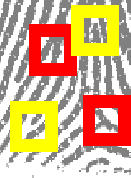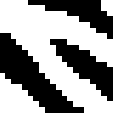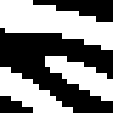Neural Networks Project: Minutiae Classification
This page describes a collection of possible projects that qualify for the
examination of the elective course Neural
Networks. All projects deal with aspects of fingerprint
verification.
Fingerprints and Minutiae
 As fingerprints differ from person to person, they can be used for
purposes of verification. Fingerprints are composed of line patterns
called ridges and valleys.
The picture at the right shows a small part of a fingerprint. In the
picture, ridges are
black (dark gray) and valleys are white (light gray).
Note that pores appear as
white dots on the
ridges. Ridges and valleys
run in parallel in most places. Sometimes
a ridge ends or bifurcates
(a valley bifurcates where a ridge ends and
vice versa). These irregularities in the pattern are called
minutiae. The locations of the minutiae are very valuable in
fingerprint verification: they are the features that make it possible to
distinguish one
fingerprint from another. The picture below shows some minutiae in a
fingerprint: bifurcations are enclosed in red squares and ridge endings in
yellow ones.
As fingerprints differ from person to person, they can be used for
purposes of verification. Fingerprints are composed of line patterns
called ridges and valleys.
The picture at the right shows a small part of a fingerprint. In the
picture, ridges are
black (dark gray) and valleys are white (light gray).
Note that pores appear as
white dots on the
ridges. Ridges and valleys
run in parallel in most places. Sometimes
a ridge ends or bifurcates
(a valley bifurcates where a ridge ends and
vice versa). These irregularities in the pattern are called
minutiae. The locations of the minutiae are very valuable in
fingerprint verification: they are the features that make it possible to
distinguish one
fingerprint from another. The picture below shows some minutiae in a
fingerprint: bifurcations are enclosed in red squares and ridge endings in
yellow ones.
Goal of This Project
The central question of this project is whether minutiae can be
detected by simply inspecting small segments of a fingerprint image.
The segments considered are squares of 20 by 20 pixels (an entire
fingerprint image is about 300 by 300 pixels). These segments should
be taken as inputs of a system to be built by you. The system's output
should indicate whether or not the input segment contains a minutia. A
more refined output will also tell whether a detected minutia is an
ending or bifurcation.
As the projects proposed here are new and have not been carried out
in the past, you should not worry too much about a successful
termination. You can already obtain a good mark if you can
convincingly report that you have spent 50 hours of practical work and
followed a promising approach (you may conclude that it turned
out not to be promising at the end).
The system to be constructed should make use of techniques that have
been covered in the course. Here are some suggestions:
- Make use of the multi-layer peceptron. It should take the
image (or some preprocessed version of the image) as input and e.g.
have two output neurons. The first becomes high when the input
contains an ending, the second when it contains a bifurcation. When
no minutiae are present, both outputs should be low. You are also free
to choose another output encoding. You should train the network with
backpropagation learning (or some other method that you take from
literature).
- Store the patterns in a Hopfield associative memory. Such a
memory has stable states. After the storage of the training set, it
can be expected that the stable states can be labeled with the type of
pattern corresponding to the state. Try to investigate whether an
initial pattern not stored in the memory converges to a stable state
of the right type (ending, bifurcation, no minutiae).
- Use a Kohonen neural network or another clustering
technique. Are patterns of the same type grouped in one cluster? If
so, how does the system behave for patterns not in the training set?
- Use a genetic algorithm to build a classifier. One can
think of a classifier as a large two-level Boolean expression, a sum
of products. Assume that the expression has fixed dimensions: all
product terms contain K variables, their negations or a don't
care value (indicating that the variable is not part of the product),
there are
L product terms and the summation that generates the output
performs the OR of M product terms (there is a separate
summation for each output). The goal may be to maximize the number of
don't cares in all products while, of course, performing the right
type of classification. Try to experiment with different values for
K, L and M.
The Databases
Test data with segments of different types can be downloaded through
this page. The segments have been classified by visual inspection.
There are actually two sets of test data. The first set has been
obtained from artificial fingerprints generated by the demo software
available from the company
OPTEL. These
artificial fingerprints are binary valued (only black and white
pixels). Segments extracted from them should be easier to classify.
The table below shows (magnified) example images of the three types of
segments.
| Ending |
Bifurcation |
Parallel lines |

|

|

|
A data base of preclassified
artificial fingerprint segments is available for
downloading. Apart from the three classes mentioned, it
contains a fourth class, the class of segments that contain multiple
minutiae. The use of this class is optional. Note: Each segment is
provided as a separate tiff file; the files have been packed by
tar and gzip and can be both unpacked in a Unix/Linux
environment as well as a Microsoft environment (use e.g. WinZip).
If you consider the artificial images too easy, a data base of preclassified
natural fingerprint segments is available as well.
Please contact me if you
think that you need a larger data base. I will try to construct a larger
one.
General Remarks
-
Realize that the classifiers are not expected to be perfect and the
errors made in classification are measure for the performance. Use
half of the segments in the data base for training. How does the
classifier perform for segments from the training set? How does it
perform for the remaining segments, the segments of the test set?
-
You are allowed to reduce the problem size in order to
reduce complexity. You can e.g. subsample the image in combination
with averaging, fitering, etc. You can also perform any other type of
preprocessing that you consider appropriate as long as the main effort
of your work goes into computational intelligence techniques.
-
Before attempting to experiment with fingerprint fragments (whether
preprocessed or not) it is wise to test your algorithms and data
structures with artificial problems with much smaller input sizes.
-
If you use MATLAB, you can read the tiff files and obtain
matrix of integers representing the image with the command imread.
If you are interested, you can use a
MATLAB script written
by
Asker Bazen to display the image (stored in a matrix) on screen.
By the way, Asker is prepared to answer questions on this project in
periods that I am absent.
- Those
that prefer other programming environments (you are free in your choice)
should find their own ways to read tiff files (if you tell me, I
can publish the methods here).
Last update on:
Sat Feb 26 18:07:14 MET 2000
by Sabih Gerez.



 As fingerprints differ from person to person, they can be used for
purposes of verification. Fingerprints are composed of line patterns
called ridges and valleys.
The picture at the right shows a small part of a fingerprint. In the
picture, ridges are
black (dark gray) and valleys are white (light gray).
Note that pores appear as
white dots on the
ridges. Ridges and valleys
run in parallel in most places. Sometimes
a ridge ends or bifurcates
(a valley bifurcates where a ridge ends and
vice versa). These irregularities in the pattern are called
minutiae. The locations of the minutiae are very valuable in
fingerprint verification: they are the features that make it possible to
distinguish one
fingerprint from another. The picture below shows some minutiae in a
fingerprint: bifurcations are enclosed in red squares and ridge endings in
yellow ones.
As fingerprints differ from person to person, they can be used for
purposes of verification. Fingerprints are composed of line patterns
called ridges and valleys.
The picture at the right shows a small part of a fingerprint. In the
picture, ridges are
black (dark gray) and valleys are white (light gray).
Note that pores appear as
white dots on the
ridges. Ridges and valleys
run in parallel in most places. Sometimes
a ridge ends or bifurcates
(a valley bifurcates where a ridge ends and
vice versa). These irregularities in the pattern are called
minutiae. The locations of the minutiae are very valuable in
fingerprint verification: they are the features that make it possible to
distinguish one
fingerprint from another. The picture below shows some minutiae in a
fingerprint: bifurcations are enclosed in red squares and ridge endings in
yellow ones.


